Collection Box Removal Process - Eastern Area
Background
Mail collection boxes are a visible representation of the U.S. Postal Service to the American public and are reliable, secure, and convenient receptacles for mail. As the Postal Service adapts its collection infrastructure to meet customers’ needs at a reasonable cost, it has eliminated underused collection boxes that on average receive fewer than 25 pieces a day, and added collection boxes that are convenient for customers.
To identify underused collection boxes the Postal Service uses density tests to determine the average volume of mail collected, including an annual national density test, which was last conducted over a 2-week period in August and September 2015.
Nationally the number of collection boxes declined by more than 12,000 in the past 5 years. Some customers have complained the Postal Service has gone too far and removed most collection boxes, except those at the Post Office. In addition, they have questioned whether any cost savings result from collection box removals.
The Eastern Area had 28,670 collection boxes on October 1, 2014, and removed 353 collection boxes through February 29, 2016. Reasons for the removals included safety, multiple boxes at a location, and canceled contracts with contract postal units. Other factors management considered for removing boxes included the volume of mail collected, the proximity of other publicly accessible collection points, and the needs of customers in the vicinity of the box. Nationally the number of collection boxes declined by more than 12,000 in the past 5 years.
Our objective was to assess the collection box removal process in the Eastern Area.
What the OIG Found
The Eastern Area’s collection box removal process was not effective. While the area and its 10 districts had established procedures for removing and relocating collection boxes, they were not consistently followed. Specifically, only 60 of the 6,371 underused business and residential collection boxes identified during the 2015 national density test were removed or relocated. Our analysis indicated an additional 1,808 collection boxes could have been removed and another 637 relocated.
Furthermore, for the period October 1, 2014, through February 29, 2016, 213 collection boxes were deleted from the Collection Point Management System without Eastern Area approval and 322 out-of-service boxes were permanently removed from the street without Eastern Area approval or public notification to customers.
These conditions occurred because there was limited area and district oversight to approve and validate collection box removals or relocations. Also, officials did not continually review collection operations data to remove or relocate underused collection boxes to ensure efficient and economical operations. Finally, there were no procedures to consistently monitor collection boxes reported as out of service longer than 7 days.
As a result, the Postal Service may be incurring additional costs to collect from and maintain underused collection boxes that could be removed. We estimate removing unnecessary collection boxes throughout the Eastern Area would eliminate 73,043 workhours over the next 5 years, for an average future cost avoidance of more than $700,000 annually. In addition, relocating underused collection boxes to more visible, higher traffic, and secure locations can better meet the needs of the customer to safely and easily access collection boxes.
What the OIG Recommended
We recommended management require each district to periodically evaluate whether to relocate or remove underused collection boxes included in the annual density test, maintain supporting documentation for removal and relocation decisions, and establish a process to monitor out-of-service collection boxes, including obtaining approvals and public notification.

